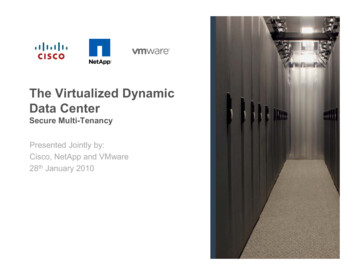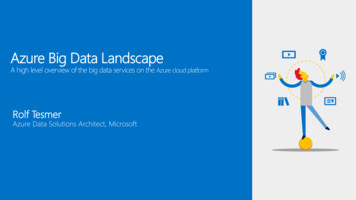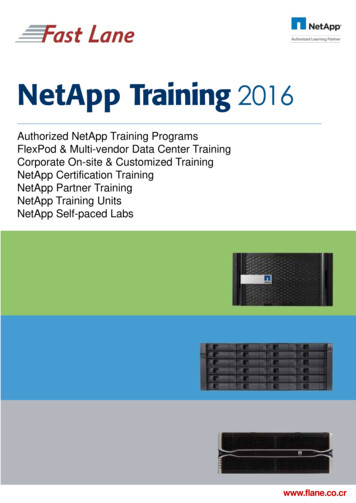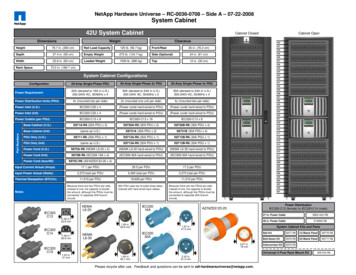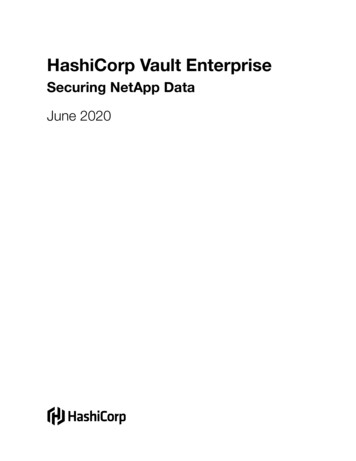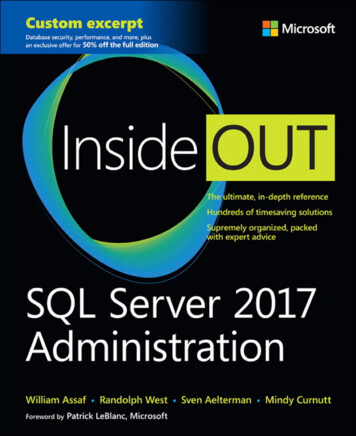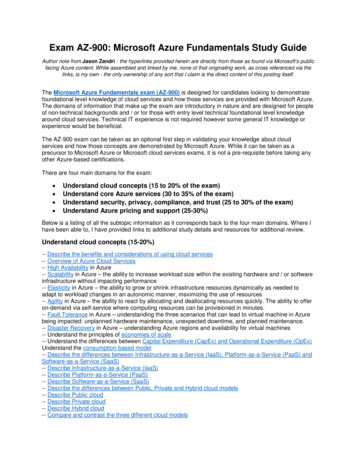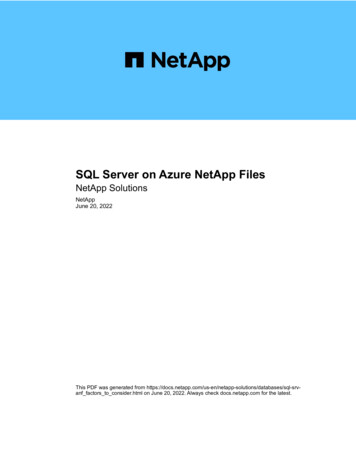
Transcription
SQL Server on Azure NetApp FilesNetApp SolutionsNetAppJune 20, 2022This PDF was generated from abases/sql-srvanf factors to consider.html on June 20, 2022. Always check docs.netapp.com for the latest.
Table of ContentsTR-4897: SQL Server on Azure NetApp Files - Real Deployment View . . . . . . . . . . . . . . . . . . . . . . . . . . . . . . . 1Use case . . . . . . . . . . . . . . . . . . . . . . . . . . . . . . . . . . . . . . . . . . . . . . . . . . . . . . . . . . . . . . . . . . . . . . . . . . . . . 1Factors to consider. . . . . . . . . . . . . . . . . . . . . . . . . . . . . . . . . . . . . . . . . . . . . . . . . . . . . . . . . . . . . . . . . . . . . . 1Real-time, high-level reference design. . . . . . . . . . . . . . . . . . . . . . . . . . . . . . . . . . . . . . . . . . . . . . . . . . . . . . . 6Conclusion . . . . . . . . . . . . . . . . . . . . . . . . . . . . . . . . . . . . . . . . . . . . . . . . . . . . . . . . . . . . . . . . . . . . . . . . . . . 13Where to find additional information. . . . . . . . . . . . . . . . . . . . . . . . . . . . . . . . . . . . . . . . . . . . . . . . . . . . . . . . 13
TR-4897: SQL Server on Azure NetApp Files Real Deployment ViewNiyaz Mohamed, NetAppIT organizations face constant change. Gartner reports nearly 75% of all databases will require cloud-basedstorage by 2022. As a leading relational database management system (RDBMS), Microsoft SQL Server is thego-to choice for Windows platform-designed applications and organizations that rely on SQL Server foreverything from enterprise resource planning (ERP) to analytics to content management. SQL Server hashelped to revolutionize the way enterprises manage massive data sets and power their applications to meetthe schema and query performance demands.Most IT organizations follow a cloud-first approach. Customers in a transformation phase evaluate their currentIT landscape and then migrate their database workloads to the cloud based on an assessment and discoveryexercise. Some factors driving customers toward cloud migration include elasticity/burst, data center exit, datacenter consolidation, end-of-life scenarios, mergers, acquisitions, and so on. The reason for migration can varybased on each organization and their respective business priorities. When moving to the cloud, choosing theright cloud storage is very important in order to unleash the power of SQL Server database cloud deployment.Use caseMoving the SQL Server estate to Azure and integrating SQL Server with Azure’s vast array of platform-as-aservice (PaaS) features such as Azure Data Factory, Azure IoT Hub, and Azure Machine Learning createstremendous business value to support digital transformation. Adopting the cloud also enables the respectivebusiness unit to focus on productivity and delivering new features and enhancements faster (DevTest usecase) than relying on the CAPEX model or traditional private cloud models. This document covers a real-timedeployment of SQL Server Always On availability group (AOAG) on Azure NetApp Files leveraging AzureVirtual Machines.Azure NetApp Files provides enterprise-grade storage with continuously available file shares. Continuouslyavailable shares are required by SQL Server production databases on SMB file share to make sure that thenode always has access to the database storage, including during disruptive scenarios such as controllerupgrades or failures. Continuously available file shares eliminate the need to replicate data between storagenodes. Azure NetApp Files uses SMB 3.0 scale-out, persistent handles, and transparent failover to supportnondisruptive operations (NDOs) for planned and unplanned downtime events, including many administrativetasks.When planning cloud migrations, you should always evaluate the best approach to use. The most common andeasiest approach for application migration is rehosting (also known as lift and shift). The example scenarioprovided in this document uses the rehosting method. SQL Server on Azure virtual machines with AzureNetApp Files allows you to use full versions of SQL Server in the cloud without having to manage on-premiseshardware. SQL Server virtual machines (VMs) also simplify licensing costs when you pay as you go andprovides elasticity and bursting capabilities for development, test, and estate refresh scenarios.Factors to considerVM performanceSelecting the right VM size is important for optimal performance of a relational database in a public cloud.Microsoft recommends that you continue using the same database performance-tuning options that areapplicable to SQL Server in on-premises server environments. Use memory-optimized VM sizes for the bestperformance of SQL Server workloads. Collect the performance data of existing deployment to identify the1
RAM and CPU utilization while choosing the right instances. Most deployments choose between the D, E, or Mseries.Notes: For the best performance of SQL Server workloads, use memory-optimized VM sizes. NetApp and Microsoft recommend that you identify the storage performance requirements before choosingthe instance type with the appropriate memory-to-vCore ratio. This also helps select a lower-instance typewith the right network bandwidth to overcome storage throughput limits of the VM.VM redundancyTo increase redundancy and high availability, SQL Server VMs should either be in the same availability set ordifferent availability zones. When creating Azure VMs, you must choose between configuring availability setsversus availability zones; an Azure VM cannot participate in both.High availabilityFor high availability, configuring SQL Server AOAG or Always On Failover Cluster Instance (FCI) is the bestoption. For AOAG, this involves multiple instances of SQL Server on Azure Virtual Machines in a virtualnetwork. If high availability is required at the database level, consider configuring SQL Server availabilitygroups.Storage configurationMicrosoft SQL Server can be deployed with an SMB file share as the storage option. Starting with SQL Server2012, system databases (master, model, msdb, or tempdb), and user databases can be installed with ServerMessage Block (SMB) file server as a storage option. This applies to both SQL Server stand-alone and SQLServer FCI.File share storage for SQL Server databases should support continuously available property.This provides uninterrupted access to the file-share data.Azure NetApp Files provides high performing file storage to meet any demanding workload, and it reducesSQL Server TCO as compared to block storage solutions. With block storage, VMs have imposed limits on I/Oand bandwidth for disk operations; network bandwidth limits alone are applied against Azure NetApp Files. Inother words, no VM-level I/O limits are applied to Azure NetApp Files. Without these I/O limits, SQL Serverrunning on smaller VMs connected to Azure NetApp Files can perform as well as SQL Server running on muchlarger VMs. Azure NetApp Files reduce SQL Server deployment costs by reducing compute and softwarelicensing costs. For detailed cost analysis and performance benefits of using Azure NetApp Files for SQLServer deployment, see the Benefits of using Azure NetApp Files for SQL Server deployment.BenefitsThe benefits of using Azure NetApp Files for SQL Server include the following: Using Azure NetApp Files allows you to use smaller instances, thus reducing compute cost. Azure NetApp Files also reduces software licensing costs, which reduce the overall TCO. Volume reshaping and dynamic service level capability optimizes cost by sizing for steady-state workloadsand avoiding overprovisioning.Notes:2
To increase redundancy and high availability, SQL Server VMs should either be in the same availability setor in different availability zones. Consider file path requirements if user-defined data files are required; inwhich case, select SQL FCI over SQL AOAG. The following UNC path is supported: \\ANFSMB-b4ca.anf.test\SQLDB and \\ANFSMBb4ca.anf.test\SQLDB\. The loopback UNC path is not supported. For sizing, use historic data from your on-premises environment. For OLTP workloads, match the targetIOPS with performance requirements using workloads at average and peak times along with the diskreads/sec and disk writes/sec performance counters. For data warehouse and reporting workloads, matchthe target throughput using workloads at average and peak times and the disk read bytes/sec and diskwrite bytes/sec. Average values can be used in conjunction with volume reshaping capabilities.Create continuously available sharesCreate continuously available shares with the Azure portal or Azure CLI. In the portal, select the EnableContinuous Availability property option. for the Azure CLI, specify the share as a continuously available shareby using the az netappfiles volume create with the smb-continuously-avl option set to True. To learn more about creating a new, continuous availability-enabled volume, see Creating aContinuously Available Share.Notes: Enable continuous availability for the SMB volume as shown in the following image. If a non-administrator domain account is used, make sure the account has the required security privilegeassigned. Set the appropriate permissions at the share level and proper file-level permissions. A continuously available property cannot be enabled on existing SMB volumes. To convert an existingvolume to use a continuously available share, use NetApp Snapshot technology. For more information, seeConvert existing SMB volumes to use Continuous Availability.3
PerformanceAzure NetApp Files supports three service levels: Standard (16MBps per terabyte), Premium (64MBps perterabyte), and Ultra (128MBps per terabyte). Provisioning the right volume size is important for optimalperformance of the database workload. With Azure NetApp Files, volume performance and the throughput limitare based on a combination of the following factors: The service level of the capacity pool to which the volume belongs The quota assigned to the volume The quality of service (QoS) type (auto or manual) of the capacity poolFor more information, see Service levels for Azure NetApp Files.4
Performance validationAs with any deployment, testing the VM and storage is critical. For storage validation, tools such asHammerDB, Apploader, the SQL Server storage benchmark (SB) tool, or any custom script or FIO with theappropriate read/write mix should be used. Keep in mind however that most SQL Server workloads, even busyOLTP workloads, are closer to 80%–90% read and 10%–20% write.To showcase performance, a quick test was performed against a volume using premium service levels. In thistest, the volume size was increased from 100GB to 2TB on the fly without any disruption to application accessand zero data migration.Here is another example of real time performance testing with HammerDB performed for the deploymentcovered in this paper. For this testing, we used a small instance with eight vCPUs, a 500GB Premium SSD,5
and a 500GB SMB Azure NetApp Files volume. HammerDB was configured with 80 warehouses and eightusers.The following chart shows that Azure NetApp Files was able to deliver 2.6x the number of transactions perminute at 4x lower latency when using a comparable sized volume (500GB).An additional test was performed by resizing to a larger instance with 32x vCPUs and a 16TB Azure NetAppFiles volume. There was a significant increase in transactions per minute with consistent 1ms latency.HammerDB was configured with 80 warehouses and 64 users for this test.Cost optimizationAzure NetApp Files allows nondisruptive, transparent volume resizing and the ability to change the servicelevels with zero downtime and no effect on applications. This is a unique capability allowing dynamic costmanagement that avoids the need to perform database sizing with peak metrics. Rather, you can use steadystate workloads, which avoids upfront costs. The volume reshaping and dynamic service-level change allowsyou to adjust the bandwidth and service level of Azure NetApp Files volumes on demand almostinstantaneously without pausing I/O, while retaining data access.Azure PaaS offerings such as LogicApp or Functions can be used to easily resize the volume based on aspecific webhook or alert rule trigger to meet the workload demands while dynamically handling the cost.For example, consider a database that needs 250MBps for steady state operation; however, it also requires apeak throughput of 400MBps. In this case, the deployment should be performed with a 4TB volume within thePremium service level to meet the steady-state performance requirements. To handle the peak workload,increase the volume size using Azure functions to 7TB for that specific period, and then downsize the volumeto make the deployment cost effective. This configuration avoids overprovisioning of the storage.Real-time, high-level reference designThis section covers a real-time deployment of a SQL database estate in an AOAG configuration using anAzure NetApp Files SMB volume. Number of nodes: 46
Number of databases: 21 Number of availability groups: 4 Backup retention: 7 days Backup archive: 365 daysDeploying FCI with SQL Server on Azure virtual machines with an Azure NetApp Files shareprovides a cost-efficient model with a single copy of the data. This solution can prevent add-fileoperation issues if the file path differs from the secondary replica.The following image shows the databases within AOAG spread across the nodes.7
Data layoutThe user database files (.mdf) and user database transaction log files (.ldf) along with tempDB are stored onthe same volume. The service level is Ultra.The configuration consists of four nodes and four AGs. All 21 databases (part of Dynamic AX, SharePoint,RDS connection broker, and indexing services) are stored on the Azure NetApp Files volumes. The databasesare balanced between the AOAG nodes to use the resources on the nodes effectively. Four D32 v3 instancesare added in the WSFC, which participates in the AOAG configuration. These four nodes are provisioned in theAzure virtual network and are not migrated from on-premises.Notes: If the logs require more performance and throughput depending on the nature of the application and thequeries executed, the database files can be placed on the Premium service level, and the logs can bestored at the Ultra service level. If the tempdb files have been placed on Azure NetApp Files, then the Azure NetApp Files volume shouldbe separated from the user database files. Here is an example distribution of the database files in AOAG.Notes: To retain the benefits of Snapshot copy-based data protection, NetApp recommends not combining dataand log data into the same volume. An add-file operation performed on the primary replica might fail on the secondary databases if the file pathof a secondary database differs from the path of the corresponding primary database. This can happen ifthe share path is different on primary and secondary nodes (due to different computer accounts). Thisfailure could cause the secondary databases to be suspended. If the growth or performance pattern cannotbe predicted and the plan is to add files later, a SQL Server failover cluster with Azure NetApp Files is anacceptable solution. For most deployments, Azure NetApp Files meets the performance requirements.8
MigrationThere are several ways to migrate an on-premises SQL Server user database to SQL Server in an Azurevirtual machine. The migration can be either online or offline. The options chosen depend on the SQL Serverversion, business requirements, and the SLAs defined within the organization. To minimize downtime duringthe database migration process, NetApp recommends using either the AlwaysOn option or the transactionalreplication option. If it is not possible to use these methods, you can migrate the database manually.The simplest and most thoroughly tested approach for moving databases across machines is backup andrestore. Typically, you can start with a database backup followed by a copy of the database backup into Azure.You can then restore the database. For the best data transfer performance, migrate the database files into theAzure VM using a compressed backup file. The high-level design referenced in this document uses the backupapproach to Azure file storage with Azure file sync and then restore to Azure NetApp files.Azure Migrate can be used to discover, assess, and migrate SQL Server workloads.To perform a migration, complete the following high-level steps:1. Based on your requirements, set up connectivity.2. Perform a full database backup to an on-premises file-share location.3. Copy the backup files to an Azure file share with Azure file sync.4. Provision the VM with the desired version of SQL Server.5. Copy the backup files to the VM by using the copy command from a command prompt.6. Restore the full databases to SQL Server on Azure virtual machines.To restore 21 databases, it took approximately nine hours. This approach is specific to thisscenario. However, other migration techniques listed below can be used based on your situationand requirements.Other migration options to move data from an on-premises SQL Server to Azure NetApp Files include thefollowing: Detach the data and log files, copy them to Azure Blob storage, and then attach them to SQL Server in theAzure VM with an ANF file share mounted from the URL. If you are using Always On availability group deployment on-premises, use the Add Azure Replica Wizardto create a replica in Azure and then perform failover. Use SQL Server transactional replication to configure the Azure SQL Server instance as a subscriber,disable replication, and point users to the Azure database instance. Ship the hard drive using the Windows Import/Export Service.Backup and recoveryBackup and recovery are an important aspect of any SQL Server deployment. It is mandatory to have theappropriate safety net to quickly recover from various data failure and loss scenarios in conjunction with highavailability solutions such as AOAG. SQL Server Database Quiesce Tool, Azure Backup (streaming), or anythird-party backup tool such as Commvault can be used to perform an application- consistent backup of thedatabases,Azure NetApp Files Snapshot technology allows you to easily create a point-in-time (PiT) copy of the userdatabases without affecting performance or network utilization. This technology also allows you to restore a9
Snapshot copy to a new volume or quickly revert the affected volume to the state it was in when that Snapshotcopy was created by using the revert volume function. The Azure NetApp Files snapshot process is very quickand efficient, which allows for multiple daily backups, unlike the streaming backup offered by Azure backup.With multiple Snapshot copies possible in a given day, the RPO and RTO times can be significantly reduced.To add application consistency so that data is intact and properly flushed to the disk before the Snapshot copyis taken, use the SQL Server database quiesce tool (SCSQLAPI tool; access to this link requires NetApp SSOlogin credentials). This tool can be executed from within PowerShell, which quiesces the SQL Server databaseand in turn can take the application-consistent storage Snapshot copy for backups.*Notes: * The SCSQLAPI tool only supports the 2016 and 2017 versions of SQL Server. The SCSQLAPI tool only works with one database at a time. Isolate the files from each database by placing them onto a separate Azure NetApp Files volume.Because of SCSQL API’s vast limitations, Azure Backup was used for data protection in order to meet the SLArequirements. It offers a stream-based backup of SQL Server running in Azure Virtual Machines and AzureNetApp Files. Azure Backup allows a 15-minute RPO with frequent log backups and PiT recovery up to onesecond.MonitoringAzure NetApp Files is integrated with Azure Monitor for the time series data and provides metrics on allocatedstorage, actual storage usage, volume IOPS, throughput, disk read bytes/sec, disk write bytes/sec, diskreads/sec and disk writes/sec, and associated latency. This data can be used to identify bottlenecks withalerting and to perform health checks to verify that your SQL Server deployment is running in an optimalconfiguration.In this HLD, ScienceLogic is used to monitor Azure NetApp Files by exposing the metrics using the appropriateservice principal. The following image is an example of the Azure NetApp Files Metric option.DevTest using thick clonesWith Azure NetApp Files, you can create instantaneous copies of databases to test functionality that should beimplemented by using the current database structure and content during the application development cycles, touse the data extraction and manipulation tools when populating data warehouses, or to even recover data thatwas mistakenly deleted or changed. This process does not involve copying data from Azure Blob containers,which makes it very efficient. After the volume is restored, it can be used for read/write operations, whichsignificantly reduces validation and time to market. This needs to be used in conjunction with SCSQLAPI forapplication consistency. This approach provides yet another continuous cost optimization technique along with10
Azure NetApp Files leveraging the Restore to New volume option.Notes: The volume created from the Snapshot copy using the Restore New Volume option consumes capacityfrom the capacity pool. You can delete the cloned volumes by using REST or Azure CLI to avoid additional costs (in case thecapacity pool must be increased).Hybrid storage optionsAlthough NetApp recommends using the same storage for all the nodes in SQL Server availability groups,there are scenarios in which multiple storage options can be used. This scenario is possible for Azure NetAppFiles in which a node in AOAG is connected with an Azure NetApp Files SMB file share and the second nodeis connected with an Azure Premium disk. In these instances, make sure that the Azure NetApp Files SMBshare is holding the primary copy of the user databases and the Premium disk is used as the secondary copy.Notes: In such deployments, to avoid any failover issues, make sure that continuous availability is enabled on theSMB volume. With no continuously available attribute, the database can fail if there is any backgroundmaintenance at the storage layer. Keep the primary copy of the database on the Azure NetApp Files SMB file share.Business continuityDisaster recovery is generally an afterthought in any deployment. However, disaster recovery must beaddressed during the initial design and deployment phase to avoid any impact to your business. With AzureNetApp Files, the cross-region replication (CRR) functionality can be used to replicate the volume data at theblock level to the paired region to handle any unexpected regional outage. The CRR-enabled destinationvolume can be used for read operations, which makes it an ideal candidate for disaster recovery simulations.In addition, the CRR destination can be assigned with the lowest service level (for instance, Standard) toreduce the overall TCO. In the event of a failover, replication can be broken, which makes the respectivevolume read/write capable. Also, the service level of the volume can be changed by using the dynamic servicelevel functionality to significantly reduce disaster recovery cost. This is another unique feature of Azure NetAppFiles with block replication within Azure.Long-term Snapshot copy archiveMany organizations must perform long-term retention of snapshot data from database files as a mandatorycompliance requirement. Although this process is not used in this HLD, it can be easily accomplished by usinga simple batch script using AzCopy to copy the snapshot directory to the Azure Blob container. The batchscript can be triggered based on a specific schedule by using scheduled tasks. The process isstraightforward—it includes the following steps:1. Download the AzCopy V10 executable file. There is nothing to install because it is an exe file.2. Authorize AzCopy by using a SAS token at the container level with the appropriate permissions.3. After AzCopy is authorized, the data transfer begins.Notes: In batch files, make sure to escape the % characters that appear in SAS tokens. This can be done byadding an additional % character next to existing % characters in the SAS token string.11
The Secure Transfer Required setting of a storage account determines whether the connection to astorage account is secured with Transport Layer Security (TLS). This setting is enabled by default. Thefollowing batch script example recursively copies data from the Snapshot copy directory to a designatedBlob container:SET source "Z:\ snapshot"echo %source%SETdest t?sp racwdl&st 2020-10-21T18:41:35Z&se 2021-10-22T18:41:00Z&sv 2019-12-12&sr c&sig ho %dest%The following example cmd is executed in PowerShell:–recursiveINFO: Scanning.INFO: Any empty folders will not be processed, because source and/ordestination doesn't have full folder supportJob b3731dd8-da61-9441-7281-17a4db09ce30 has startedLog file is located at: db09ce30.log0.0 %, 0 Done, 0 Failed, 2 Pending, 0 Skipped, 2 Total,INFO: azcopy.exe: A newer version 10.10.0 is available to download0.0 %, 0 Done, 0 Failed, 2 Pending, 0 Skipped, 2 Total,Job b3731dd8-da61-9441-7281-17a4db09ce30 summaryElapsed Time (Minutes): 0.0333Number of File Transfers: 2Number of Folder Property Transfers: 0Total Number of Transfers: 2Number of Transfers Completed: 2Number of Transfers Failed: 0Number of Transfers Skipped: 0TotalBytesTransferred: 5Final Job Status: CompletedNotes: A similar backup feature for long-term retention will soon be available in Azure NetApp Files. The batch script can be used in any scenario that requires data to copied to Blob container of any region.12
Cost optimizationWith volume reshaping and dynamic service level change, which is completely transparent to the database,Azure NetApp Files allows continuous cost optimizations in Azure. This capability is used in this HLDextensively to avoid overprovisioning of additional storage to handle workload spikes.Resizing the volume can be easily accomplished by creating an Azure function in conjunction with the Azurealert logs.ConclusionWhether you are targeting an all-cloud or hybrid cloud with stretch databases, Azure NetApp Files providesexcellent options to deploy and manage the database workloads while reducing your TCO by making datarequirements seamless to the application layer.This document covers recommendations for planning, designing, optimizing, and scaling Microsoft SQL Serverdeployments with Azure NetApp Files, which can vary greatly between implementations. The right solutiondepends on both the technical details of the implementation and the business requirements driving the project.TakeawaysThe key points of this document include: You can now use Azure NetApp Files to host the database and file share witness for SQL Server cluster. You can boost the application response times and deliver 99.9999% availability to provide access to SQLServer data when and where it is needed. You can simplify the overall complexity of the SQL Server deployment and ongoing management, such asraid striping, with simple and instant resizing. You can rely on intelligent operations features to help you deploy SQL Server databases in minutes andspeed development cycles. If Azure Cloud is the destination, Azure NetApp Files is the right storage solution for optimized deployment.Where to find additional informationTo learn more about the information described in this document, refer to the following website links: Solution architectures using Azure NetApp ures Benefits of using Azure NetApp Files for SQL Server files-sql-server SQL Server on Azure Deployment Guide Using Azure NetApp Fileshttps://www.netapp.com/pdf.html?item /media/27154-tr-4888.pdf Fault tolerance, high availability, and resilience with Azure NetApp th-azurenetapp-files13
Copyright InformationCopyright 2022 NetApp, Inc. All rights reserved. Printed in the U.S. No part of this documentcovered by copyright may be reproduced in any form or by any means-graphic, electronic, ormechanical, including photocopying, recording, taping, or storage in an electronic retrieval systemwithout prior written permission of the copyright owner.Software derived from copyrighted NetApp material is subject to the following license and disclaimer:THIS SOFTWARE IS PROVIDED BY NETAPP “AS IS” AND WITHOUT ANY EXPRESS OR IMPLIEDWARRANTIES, INCLUDING, BUT NOT LIMITED TO, THE IMPLIED WARRANTIES OFMERCHANTABILITY AND FITNESS FOR A PARTICULAR PURPOSE, WHICH ARE HEREBYDISCLAIMED. IN NO EVENT SHALL NETAPP BE LIABLE FOR ANY DIRECT, INDIRECT,INCIDENTAL, SPECIAL, EXEMPLARY, OR CONSEQUENTIAL DAMAGES (INCLUDING, BUT NOTLIMITED TO, PROCUREMENT OF SUBSTITUTE GOODS OR SERVICES; LOSS OF USE, DATA, ORPROFITS; OR BUSINESS INTERRUPTION) HOWEVER CAUSED AND ON ANY THEORY OFLIABILITY, WHETHER IN CONTRACT, STRICT LIABILITY, OR TORT (INCLUDING NEGLIGENCE OROTHERWISE) ARISING IN ANY WAY OUT OF THE USE OF THIS SOFTWARE, EVEN IF ADVISED OFTHE POSSIBILITY OF SUCH DAMAGE.NetApp reserves the right to change any products described herein at any time, and without notice.NetApp assumes no responsibility or liability arising from the use of products
option. For AOAG, this involves multiple instances of SQL Server on Azure Virtual Machines in a virtual network. If high availability is required at the database level, consider configuring SQL Server availability groups. Storage configuration Microsoft SQL Server can be deployed with an SMB file share as the storage option. Starting with SQL .

